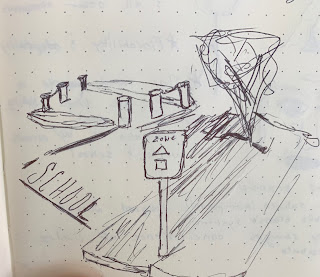Our first full day in Utrecht started with a meeting in Utrecht's city hall with traffic engineer Ronald Tamse. The first thing on our agenda was a presentation Ronald put together for us. One of the first things he showed us was this graph showing the transportation priority:
Ronald also touched on the perks of simplicity. Here they think of the bike as a simple tool rather than an accessory. They also focus on making the streets safe and simple. Take school zones for instance. The make them extremely safe without a bunch of obnoxious signage and painting. Heres a sketch of one done in my notebook:
This shows the growing priority of bicycles around the world and in Holland specifically. In fact, he argued that they have more priority in the Netherlands and Utrecht than in Copenhagen. I have to say I agree with him as well. While biking around the city you get the feeling that bikes and the people riding them are more important and more powerful than motor vehicles. This sort of thing causes more people to bike out of sheer convenience, and when there's less traffic on the street it creates more sociability on the street. Through this process, streets can become social or public spaces, rather than just a piece of pavement made for cars to drive on. This is great because so much of a cities infrastructure is taken up by streets, and turning them into public spaces allows the creation of stronger communities.
Another thing Ronald mentioned that really stuck with me was that you can't "only invest in hardware (infrastructure), but also software (behavior and education)". This thought is becoming a common theme in these easily bikable cities. Here in Utrecht, they focus on teaching kids at a young age how to get around on a bike. They put on traffic eduction in schools, encourage kids and parents to cycle together as much as possible, and even have biking tests in middle school. When you couple this sort of software with the impeccable hardware infrastructure not only the Netherlands but Sweden and Denmark have put in place you get one heck of a transportation computer.
Ronald also touched on the perks of simplicity. Here they think of the bike as a simple tool rather than an accessory. They also focus on making the streets safe and simple. Take school zones for instance. The make them extremely safe without a bunch of obnoxious signage and painting. Heres a sketch of one done in my notebook:
After the presentation, Ronald took us two of Utrechts underground bike parking facilities. Together they can hold over 12,00 bicycles.
You could even bike through the second one, and each had multiple floors. This sort of thing is where you can really see the priority of bikes over cars. It's so refreshing to see that some places in the world will actually put bikes ahead of cars to this extent. And it's hard not to blame them, they've been taught from a young age that bikes are the way to go, so why would they expect anything else?




Comments
Post a Comment